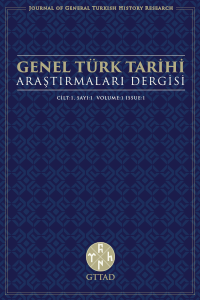İDİL-URAL VE TÜRKİSTAN’DA FİKİR HAREKETLERİ-DİNİ ISLAHÇILIK VE CEDİTÇİLİK
Ceditçilik, 19. yüzyılın sonlarında Çarlık Rusya içerisindeki Türk kökenli Müslüman halklar arasında ortaya çıkan sosyal ve siyasi bir aydınlanma hareketidir. 19. yüzyılın sonlarına kadar Rusya Müslümanlarında eğitim medreselerde veriliyordu. “Usul-i Kadim” denilen bu geleneksel eğitim yönteminde muallim her öğrenciye tek tek ders veriyordu, bu durum da eğitim süresinin uzamasına sebep oluyordu. Medreselerde okuma yazma öğretiminin dışında Kur’an sureleri ezberletiliyor ancak öğrenciler ezberledikleri surelerin dışındaki Arapça bir kitabı okuyamıyorlardı. Ceditçiler ise bu eğitim yöntemine karşı çıkarak “Usul-i Cedid” adıyla Batıdaki eğitim sistemini örnek alan bir eğitim reformuna gitmek istiyorlardı.
Anahtar Kelimeler:
Ceditçilik, Dini Islhaçılık, İdil-Ural, Türkista
KANLIDERE, AHMET, İDİL-URAL VE TÜRKİSTAN’DA FİKİR HAREKETLERİ-DİNİ ISLAHÇILIK VE CEDİTÇİLİK. İSTANBUL: ÖTÜKEN YAYINLARI, 2021 ISBN:978-625-408-078-4
Ceditism is a social and political enlightenment movement that emerged among Muslim peoples of Turkish origin in Tsarist Russia at the end of the 19th century. Until the end of the 19th century, education in Russian Muslims was given in madrasahs. In this traditional education method called "Usul-i Kadim", the teacher gave lessons to each student one by one, and this caused the duration of education to be prolonged. In madrasas, verses of the Qur'an were memorized apart from teaching reading and writing, but students could not read an Arabic book other than the suras they had memorized. The Jadidists, on the other hand, opposed this education method and wanted to go for an education reform called "Usul-i Cedid", taking the education system of the West as an example.
Keywords:
jadid, religious reformism, İdil-Ural, Turkistan,
- Yayın Aralığı: Yılda 2 Sayı
- Başlangıç: 2019
- Yayıncı: Özgür Türker
Sayıdaki Diğer Makaleler
TİMURLULAR VE AK-KOYUNLU, KARA-KOYUNLU TÜRKMENLERİNDE KENGEŞ MECLİSİ
TÜRKİSTANLI HACI VE SEYYAHLARIN GÖZÜYLE İSTANBUL
A SINGLE GRAIN OF INDIGO: A READING ON MONGOLS AND TURKS IN THE U.S. LOCAL PRESS (1850-1923)
KIRIM’IN İŞGALİNDE DIŞİŞLERİ BAKANLIĞI VE LUDENDORFF (1918)
Winfried BAUMGART, Çevirmen: Aybüke GÜZAY
İHTİYAR B. GIYASÜDDİN (Ö. 928/1521): BİR TİMURLU KADISININ BİYOGRAFİSİ
RUSYA VE İNGİLTERE ARASINDAKİ BÜYÜK OYUN'UN DORUK NOKTASI KUŞKU SAVAŞI
19. YÜZYILDA ÇARLIK RUSYA’SININ KAZAK JÜZLERİNDE GERÇEKLEŞTİRDİĞİ İDARÎ REFORMLAR VE NETİCELERİ
TÜRK KÜLTÜRÜ DERGİSİNDE TARİH EĞİTİMİ TARTIŞMALARI (1963-1978)
